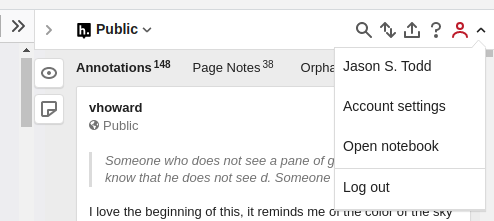Purpose
In addition to the novels and films we will be treating as the primary sources this semester, we will be reading several rather challenging articles and essays that will provide us with some of the theoretical and technical knowledge we need to critically explore the idea of dystopia. We will be using Hypothesis to explore these secondary texts by collaboratively annotating them online. Annotating a text in detail, whether a primary or secondary source, is a step towards the more expansive analyses we will be doing for this class. Annotating collaboratively will empower you to engage with these texts and your classmates in a more dynamic way.
Critically reading these articles will help you to challenge theories of social justice against various dystopian examples. Annotating them will help you to articulate multiple, competing perspectives on and to analyze the underlying assumptions of those views. Working collaboratively through Hypothesis will enable you to build collaborative relationships with colleagues representing diverse cultures, races, ages, genders, religions, lifestyles, & viewpoints, to leverage existing digital technologies ethically & efficiently to solve problems, complete tasks, & accomplish goals, and to develop proficiency as a self-regulated learner.
Connected Course Outcomes
- Identify the defining characteristics of dystopia & analyze real & imagery contexts against that definition.
- Communicate effectively through writing & speaking.
- Use quantitative, empirical, and critical reasoning skills to solve problems.
- Demonstrate personal accountability & effective work habits.
Task
For each of the assigned secondary texts, you must not only read the article before the designated class, but you must also annotate it through Hypothesis. Be sure you are logged into your Hypothesis account and be sure that under My Groups Public is selected. As we’re getting started, use the rubric below for a sense of what’s expected.
- If you need help creating your Hypothesis account, watch the “Creating a Hypothesis Account” video.
- If you need help learning what good annotating looks like, watch the “Annotating a Text” video.
- “Five Faces of Oppression” by Iris Young
- Selections from Civilization & Its Discontents by Sigmund Freud
- Chapter XIII of Leviathan by Thomas Hobbes
- “Panopticism” by Michel Foucault *
- “Dystopias Now” by Kim Stanley Robinson *
* Please note that in response to student feedback, the last two readings for this semester will be done differently, in particular, without Hypothesis. Please follow the instruction on Brightspace.
Getting Started
- Read the article! If past highlights and annotations are distracting, click on the eyeball icon to hide them.

- To annotate, select the text you are annotating, click the annotate icon, and enter your commentary into sidebar that opens. Don’t use the highlight tool. Highlighting is not the same as annotating.
- When you find a part that confuses you, look up what it means or refers to and create an annotation. If someone has already annotated it, read the annotation. Make a reply if you have something to add.
- Annotations can provide facts (definitions, explanations, etc) to clarify an idea or images (maps, animals, etc) to illustrate a concept, or they can add an insight (connect to another field or another topic) or ask a question (there’s nothing wrong with admitting you don’t understand something).
- These collaborative annotations will help you understand the article better; however, as this is an asynchronous system, keep two things in mind.
- The first people to annotate will not get as much out of the article, as they will not see (m)any other annotations. If this is the case for you, I’d suggested rereading the article again before class to see what has been added. This is also an effective exam prep method.
- For people who are the last to read the article, it will be more difficult to have something new to add, as many other people may have already made the same point or asked the same question. I’d suggest not waiting until right before class to do this assignment.
- There is no minimum number of annotations for any reading. Your annotations should show a consistent effort throughout the entirety of the text.
Evaluation
You will not receive a grade for your annotated readings. On the Grades page, you will receive one of the following designations:
- Completed (Activity was successfully submitted and met all expectations)
- Partially completed (Activity was submitted but did not meet all expectations)
- Not completed (Activity was not submitted)
Instead of a grade or score, I will give you feedback either in writing or through a short video. My feedback will focus on how well I think your work demonstrates your efforts with the learning outcomes listed above.
EXPECTATIONS
Your annotated readings must meet all of the following in order to be considered complete:
- Be completed on time.
- Demonstrate your attentive reading of the text.
- Provide multiple examples of your thoughts and questions.




